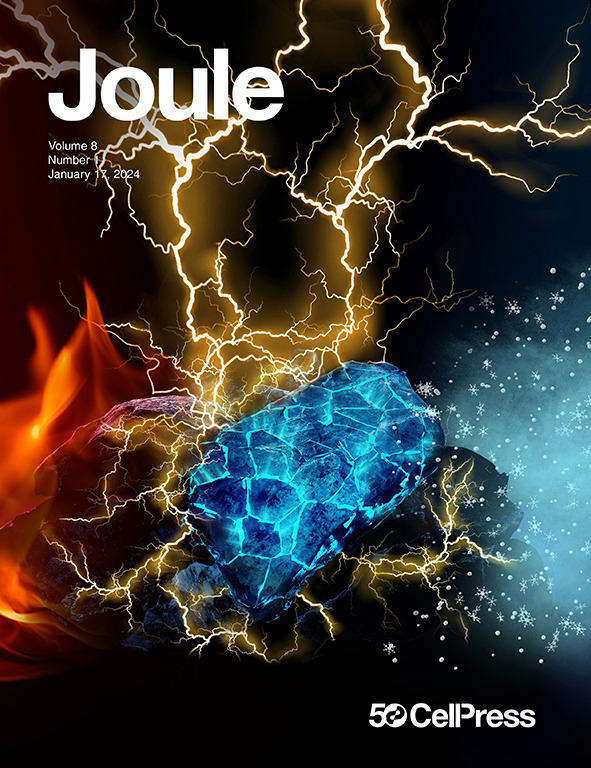含能锰离子电池的Mn2+-S氧化还原电化学研究
IF 35.4
1区 材料科学
Q1 CHEMISTRY, PHYSICAL
引用次数: 0
摘要
含水锰离子电池(AMIBs)由于其丰富的锰和其固有的安全性,近年来引起了人们的关注。然而,目前amib的发展仍然受到实际容量限制的困扰。在此,我们提出了一个具有固体-液体-固体氧化还原途径的高能Mn2+-S氧化还原电化学。Operando x射线吸收精细光谱和同步加速器x射线衍射揭示了S8↔MnS4↔MnS2↔MnS的Mn2+储存机制。可以实现1,242 mAh g−1的容量和74.3 wt %的高硫利用率,超过了先前报道的amib的容量限制。作为概念验证,集成S/MnS和MnO2/Mn2+氧化还原对的系统提供了396 Wh kgS+MnO2−1的能量密度,并在4 a g−1下稳定循环800次。我们已经阐明了Mn2+-S氧化还原的机制,并可能为下一个高能amib开辟道路。本文章由计算机程序翻译,如有差异,请以英文原文为准。


A Mn2+-S redox electrochemistry for energetic aqueous manganese ion battery
Aqueous manganese ion batteries (AMIBs) have recently garnered attention due to the abundance of manganese and their intrinsic safety. However, the development of current AMIBs remains plagued by restrictive actual capacities. Herein, we propose an energetic Mn2+-S redox electrochemistry with a solid-liquid-solid redox pathway. Operando X-ray absorption fine spectroscopy and synchrotron X-ray diffraction unveil the Mn2+ storage mechanism of S8 ↔ MnS4 ↔ MnS2 ↔ MnS. A capacity of 1,242 mAh g−1 with a high sulfur utilization of 74.3 wt % can be achieved, surpassing the capacity limitations of previously reported AMIBs. As a proof of concept, a system intergrating the S/MnS and MnO2/Mn2+ redox couples delivers an energy density of 396 Wh kgS+MnO2−1 and cycles for 800 cycles stably at 4 A g−1. We have elucidated the mechanism underlying the redox of Mn2+-S and may open an avenue for the next high-energy AMIBs.
求助全文
通过发布文献求助,成功后即可免费获取论文全文。
去求助
来源期刊

Joule
Energy-General Energy
CiteScore
53.10
自引率
2.00%
发文量
198
期刊介绍:
Joule is a sister journal to Cell that focuses on research, analysis, and ideas related to sustainable energy. It aims to address the global challenge of the need for more sustainable energy solutions. Joule is a forward-looking journal that bridges disciplines and scales of energy research. It connects researchers and analysts working on scientific, technical, economic, policy, and social challenges related to sustainable energy. The journal covers a wide range of energy research, from fundamental laboratory studies on energy conversion and storage to global-level analysis. Joule aims to highlight and amplify the implications, challenges, and opportunities of novel energy research for different groups in the field.
 求助内容:
求助内容: 应助结果提醒方式:
应助结果提醒方式:


